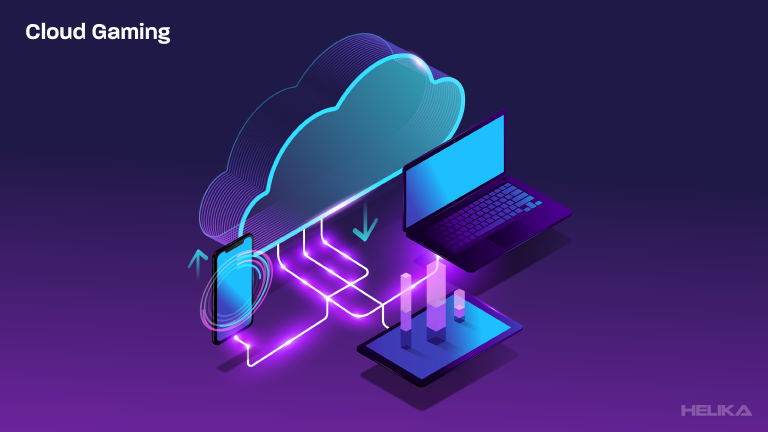The video game industry is experiencing rapid evolution, with new gaming industry trends reshaping how we play and interact with digital entertainment. From cutting-edge technology to innovative gameplay mechanics, these developments are transforming the gaming landscape at an unprecedented pace. As players and developers alike adapt to these changes, the industry continues to push boundaries and redefine what’s possible in interactive media.
Several key gaming industry trends are driving this transformation and having an impact on the future of gaming. Cloud gaming is revolutionizing access to high-quality titles, while cross-platform play is breaking down barriers between different gaming systems. Artificial intelligence is enhancing game development processes, leading to more immersive and dynamic experiences. To grasp the full scope of these changes, let’s explore five major gaming industry trends that are shaping the game industry’s future and influencing how we’ll play in the years to come.
Cloud Gaming Revolution
Cloud gaming has emerged as a groundbreaking trend in video games, reshaping how players access and enjoy their favorite titles. This innovative technology allows gamers to stream high-quality games directly to their devices without the need for powerful hardware or lengthy downloads. As the game industry continues to evolve, cloud gaming is playing a pivotal role in expanding accessibility and transforming the gaming landscape.
What is Cloud Gaming?
Cloud gaming, also known as gaming on demand or gaming as a service, is a technology that enables users to play video games remotely from powerful servers in data centers. Instead of relying on local hardware to process and render games, cloud gaming platforms stream the gameplay directly to the user’s device. This means that players can enjoy graphically intensive games on a wide range of devices, including smartphones, tablets, smart TVs, and even low-end computers.

The concept behind cloud gaming is similar to streaming services like Netflix or YouTube. Players use a client or app to log into a remote server, which runs the game and sends a live video feed back to the user’s device. The player’s inputs are then sent back to the server in real-time, creating a seamless gaming experience. This technology eliminates the need for expensive gaming hardware and allows for instant access to a vast library of games.
Benefits of Cloud Gaming
Cloud gaming offers several advantages that are contributing to its growing popularity in the game industry:
- Accessibility: One of the most significant benefits of cloud gaming is its ability to make high-quality gaming experiences accessible to a broader audience. Players no longer need to invest in expensive gaming PCs or consoles to enjoy the latest titles. This democratization of gaming has opened up new possibilities for players who may not have had access to cutting-edge hardware in the past.
- Portability: Cloud gaming allows players to access their games from virtually anywhere with a stable internet connection. This means that gamers can start a session on their home computer and continue playing on their smartphone or tablet while on the go. This flexibility has revolutionized how people engage with their favorite games.
- Instant access: With cloud gaming, there’s no need to wait for lengthy downloads or installations. Players can start gaming immediately, which is particularly appealing in an era where instant gratification is highly valued.
- Reduced hardware costs: By eliminating the need for powerful local hardware, cloud gaming can significantly reduce the cost of entry into gaming. This has the potential to expand the gaming market and bring in new players who may have been deterred by the high costs associated with traditional gaming setups.
- Automatic updates: Cloud gaming platforms handle all game updates and patches on their servers, ensuring that players always have access to the latest version of their games without any manual intervention.
Major Players in Cloud Gaming
As cloud gaming continues to gain traction, several major companies have entered the market with their own platforms:
![]()
- Google Stadia: Launched in 2019, Stadia was Google’s ambitious entry into the cloud gaming space. While the service faced challenges and ultimately shut down, it played a significant role in bringing attention to cloud gaming technology.

- NVIDIA GeForce NOW: This platform allows users to stream games they already own from various digital storefronts, making it an attractive option for PC gamers looking to play their existing library on different devices.

- Xbox Cloud Gaming: Microsoft’s cloud gaming service, part of Xbox Game Pass Ultimate, offers a growing library of games that can be streamed to various devices, including smartphones and tablets.

- Amazon Luna: Amazon’s entry into the cloud gaming market provides a subscription-based model with access to a curated selection of games.

- PlayStation Now: Sony’s cloud gaming service offers a large library of PlayStation games that can be streamed to compatible devices.
As these major players continue to invest in and refine their cloud gaming offerings, the technology is poised to become an increasingly important gaming industry trend, shaping the future for years to come.
Rise of Cross-Platform Play
Cross-platform play has emerged as a significant trend in video games, reshaping the gaming landscape and breaking down barriers between players on different platforms. This innovative feature allows gamers to connect and play together regardless of the device they’re using, whether it’s a console, PC, or mobile device. As the game industry continues to evolve, cross-platform play has become increasingly important in fostering a more inclusive and interconnected gaming experience.
Importance of Cross-Platform Gaming
The rise of cross-platform gaming has revolutionized multiplayer experiences, making it easier for friends to play together regardless of their chosen system. This trend has expanded the pool of available players, resulting in faster matchmaking times and more diverse gaming communities. For developers, cross-platform play opens up new opportunities for player engagement, retention, and monetization.
One of the primary advantages of cross-platform gaming is its ability to bring together players from different platforms, creating a more vibrant and inclusive gaming community. This expanded player base not only enhances social interactions but also ensures that players can easily find matches and engage with a larger pool of opponents and allies. As a result, cross-platform play has become a sought-after feature in modern gaming, with many popular titles embracing this trend.
Cross-platform gaming also contributes to the longevity of games by fostering competitive environments and esports scenes. By enabling players from different platforms to compete against each other, developers can create unified and robust competitive ecosystems. This not only extends the lifespan of games but also attracts a wider audience and enhances the competitive experience for both players and spectators.
Technical Challenges
While cross-platform play offers numerous benefits, it also presents several technical challenges for game developers. One of the primary issues is ensuring compatibility and optimizing performance across different platforms. Each platform may have its own hardware specifications, operating systems, and networking capabilities, which can pose significant hurdles for developers striving to create a seamless gaming experience.
Another challenge lies in balancing gameplay mechanics and accounting for different input methods across platforms. For example, the disparity between keyboard and mouse controls on PC and controller inputs on consoles can lead to imbalances in competitive gameplay. Developers must carefully consider these differences and implement appropriate control schemes and balancing mechanisms to maintain an equitable experience for all players.
Security and cheating concerns also arise with cross-platform play. The open nature of this feature introduces vulnerabilities that developers must address to protect player data, prevent hacking, and detect cheating behaviors. Maintaining a fair and secure gameplay environment across platforms requires continuous monitoring, updates, and cooperation with platform holders to mitigate these risks effectively.
Popular Cross-Platform Titles
Despite the challenges, many popular games have successfully implemented cross-platform play, setting new standards for the gaming industry. Some notable examples include:
![]()
- Fortnite: One of the pioneers in cross-platform gaming, Fortnite allows players on consoles, PC, and mobile devices to play together seamlessly.
![]()
- Minecraft: This beloved sandbox game supports cross-platform play across various devices, enabling players to build and explore together regardless of their chosen platform.

- Rocket League: The popular vehicular soccer game has embraced cross-platform play, allowing players on different consoles and PC to compete in matches together.
![]()
- Call of Duty: Warzone: This battle royale game supports cross-platform play and cross-progression, allowing players to maintain their progress across different devices.

- Among Us: The hit social deduction game allows players on mobile, PC, and consoles to join the same lobbies and play together.
As cross-platform play continues to gain traction, more games are likely to adopt this feature, further blurring the lines between gaming platforms and creating a more unified gaming experience for players worldwide.
Artificial Intelligence in Game Development
Artificial intelligence has emerged as a game-changing trend in video games, revolutionizing the way developers create and players experience digital entertainment. As the game industry continues to evolve, AI has become an indispensable tool for enhancing various aspects of game development, from content creation to gameplay mechanics.
AI for Procedural Content Generation
One of the most exciting applications of AI in game development is procedural content generation. This innovative approach allows developers to create vast, diverse, and detailed game worlds, levels, and assets using AI algorithms. By leveraging AI for content generation, developers can save time and ensure that players encounter fresh experiences with each playthrough.
Procedural generation powered by AI has the potential to create infinite variations of game elements, such as terrain, buildings, and even entire cities. For example, AI systems can analyze real-world architectural data and terrain information to construct realistic 3D buildings and natural landscapes for open-world game environments. This technology enables developers to rapidly construct rich, vivid game spaces that would be implausibly labor-intensive to create by hand.
The benefits of AI-driven procedural generation extend beyond just creating large-scale environments. It can also be used to generate minor game assets, such as furniture, clutter items, plants, and props. With AI, an infinite number of small 3D object models can be produced to densely populate game worlds, adding depth and realism to the gaming experience.
AI-powered NPCs
Another significant trend in video games is the development of AI-powered non-player characters (NPCs). Traditional NPCs often suffer from repetitive dialog and predictable behavior, which can break player immersion. AI has the potential to transform NPCs into more dynamic and engaging characters, enhancing the overall gaming experience.
AI-driven NPCs can exhibit realistic behaviors, learn from player interactions, and adapt their strategies, blurring the line between scripted and emergent gameplay. By using advanced AI algorithms, developers can create NPCs with distinct personalities, appearances, and behaviors that feel more lifelike and responsive to player actions.
AI can endow NPCs with far more emotional depth and variability in their reactions to game events and player actions. Their dialog can adjust on the fly to reference shared experiences they’ve had with the player, fostering more meaningful connections. This level of sophistication in NPC behavior can lead to more immersive and engaging gameplay experiences.
Machine Learning for Game Balancing
Machine learning, a subset of AI, has become an invaluable tool for game balancing. Traditionally, game designers have relied on extensive playtesting and iterative design to achieve the right balance in gameplay. However, machine learning algorithms can now analyze vast amounts of player data to uncover patterns, preferences, and pain points, informing design decisions and helping developers create more engaging gameplay experiences by leveraging AI game optimization.
By leveraging machine learning, developers can implement dynamic difficulty adjustment, ensuring that the game remains challenging and engaging for players of all skill levels. This personalized approach to gameplay can cater to both casual and hardcore players, enhancing overall player satisfaction.
Machine learning can also be used to simulate millions of gameplay sessions, allowing developers to identify potential balance issues and make necessary adjustments before release. This approach enables developers to fine-tune game mechanics, economy systems, and difficulty curves with greater precision and efficiency.
As AI continues to advance, its impact on game development will only grow stronger. From procedural content generation to lifelike NPCs and sophisticated game balancing, AI is shaping the future of the game industry and opening up new possibilities for creating immersive, dynamic, and personalized gaming experiences.
Conclusion
The video game industry is undergoing a major shift, with cloud gaming, cross-platform play, and AI significantly impacting how games are made and played. These gaming industry trends are breaking down barriers, making gaming more accessible, and creating more immersive experiences for players worldwide. AI game optimization also opens up new possibilities for developers to create richer, more dynamic game worlds and characters that respond in lifelike ways to player actions.
Looking ahead, these gaming industry trends are likely to shape the future of gaming in exciting ways. As technology advances, we can anticipate even more innovative developments that blur the lines between reality and virtual worlds. While challenges remain, the gaming industry is well-positioned to continue innovating and pushing boundaries, providing players with more engaging and interactive experiences.



